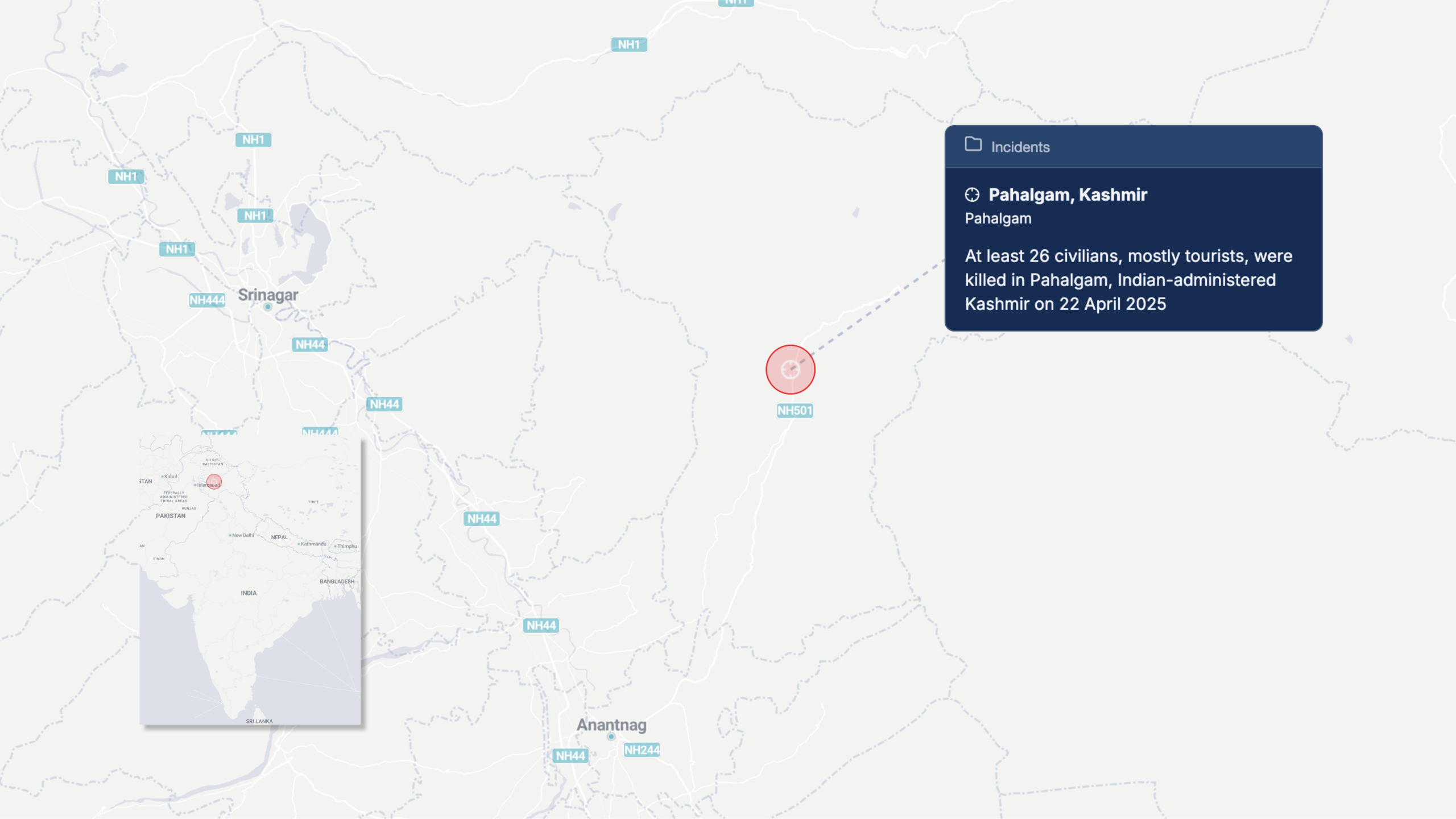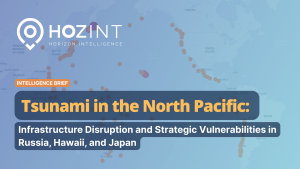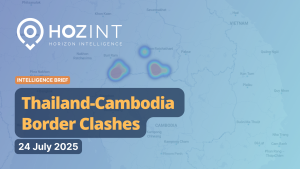Key Points:
-
At least 26 civilians, mostly tourists, were killed in Pahalgam, Indian-administered Kashmir, on 22 April 2025, marking the deadliest civilian attack since 2000.
-
The Resistance Front (TRF), an offshoot of Lashkar-e-Taiba, claimed responsibility, citing opposition to demographic changes and the settlement of “outsiders.”
-
India responded swiftly, increasing troop deployments and issuing retaliatory measures, including curtailing visa policies and suspending cooperation under the Indus Water Treaty.
-
This attack undermines the Indian government’s narrative of stability and normalcy in Kashmir since its revocation of Article 370 in 2019.
-
Heightened tensions between India and Pakistan suggest an elevated risk of military escalation, echoing the 2019 Pulwama-Balakot cycle.
Event Summary
What happened:
On 22 April 2025, unidentified gunmen attacked Indian and Nepali tourists in the Baisaran Valley, near Pahalgam, a popular tourist destination in Indian-administered Kashmir. 26 people were killed, with survivors reporting that victims were accused of supporting Prime Minister Narendra Modi before being executed at close range.
Who is responsible:
The attack was claimed by The Resistance Front (TRF), a group believed to be a proxy of Lashkar-e-Taiba (LeT). TRF has previously targeted minorities and is categorised as a terrorist organisation by the Indian government.
Where:
The shooting occurred in a secluded meadow of the Baisaran Valley, approximately 90 km from Srinagar, only accessible on foot or horseback.
When:
The attack took place on Tuesday, 22 April 2025, during the spring tourism peak.
Why:
TRF’s message portrayed the attack as retaliation against India’s efforts to alter Kashmir’s demography by encouraging settlement from other regions. The group’s narrative frames this as “colonial occupation” and portrays violence as resistance.
How:
Eyewitnesses recount that the gunmen targeted tourists indiscriminately, accusing them of political allegiance to Modi. The attack involved automatic weapons, and the area’s inaccessibility delayed immediate military response.
Strategic Implications for India
This massacre represents a significant challenge to the Indian government’s claim of restored peace and security in Kashmir. Since the abrogation of Article 370 in 2019, India has heavily militarised the region, suppressing dissent and promoting tourism as a soft-power strategy to normalise control. Hosting the G20 tourism meeting in Srinagar in 2023 was emblematic of this effort.
However, the attack exposes gaps in security, especially given that the region is among the most militarised in the world. The fact that attackers could reach a secluded tourist site and execute such a massacre raises questions about intelligence failures and operational readiness.
Geopolitical Tensions
India’s immediate retaliatory actions, including suspending key border crossings and visa programmes, suggest deteriorating bilateral relations with Pakistan. Notably, the suspension of India’s role in the Indus Water Treaty—a rare diplomatic success story since 1960—marks a serious escalation. Pakistan’s government has called this move an “act of warfare”, asserting that water rights are non-negotiable and crucial to its national security.
In a historical context, the Pulwama attack in 2019 led to airstrikes by India on Balakot, escalating the risk of a full-scale conflict. Given that India’s military capabilities have since grown, and Pakistan is grappling with political and economic instability, the temptation for a robust response is high.
The Role of TRF and LeT
The TRF’s emergence post-2019 reflects a tactical evolution of Lashkar-e-Taiba, designed to project militancy as indigenous and secular in response to international scrutiny on LeT and Jaish-e-Mohammed (JeM). TRF’s messaging mixes anti-India rhetoric with local grievances, attempting to gain broader appeal and deflect from Pakistani state support.
India has consistently accused Pakistan of providing safe havens to such groups—a claim that Pakistan denies but aligns with past precedent. Pakistan-based groups were also involved in the 2008 Mumbai attacks, underscoring the persistent use of asymmetric warfare tactics.
Forecast
Short-Term (0–3 months)
-
Retaliatory Indian military operations are likely in the form of surgical strikes or air raids against alleged militant infrastructure across the Line of Control (LoC).
-
Domestic unrest is likely to surge, especially in Kashmir, where civilians may face reprisals and lockdowns. Tour operators report up to 90% cancellations, threatening livelihoods and increasing resentment.
-
Anti-Muslim sentiment may rise across India, fueling sectarian tensions and complicating communal harmony.
Medium-Term (3–12 months)
-
There is a heightened risk of Indo-Pakistani military confrontation, particularly if India escalates beyond cross-border raids. Any Pakistani retaliation could spiral into a broader crisis.
-
The suspension of the Indus Water Treaty may trigger legal and diplomatic pushback, potentially involving third-party mediation.
-
International scrutiny of India’s Kashmir policy may intensify, especially if civilian rights abuses occur during crackdowns.
Long-Term (12+ months)
-
The attack could reinvigorate insurgent recruitment in Kashmir, especially among youth disillusioned by economic hardships and political repression.
-
If Modi’s government adopts a hardline approach in the upcoming elections, this could further polarise Indian society and regional politics.
-
Pakistan’s internal instability may limit its ability to moderate extremist elements, inadvertently sustaining the insurgency.
Conclusion
The Pahalgam tourist massacre marks a pivotal moment in the Kashmir conflict. It exposes the fragility of India’s security apparatus despite a heavy military footprint and threatens to destabilise India-Pakistan relations once again. The reemergence of violent militancy and possible retaliatory strikes bring the region perilously close to the brink. Given past escalatory cycles, international actors should closely monitor developments and consider mediatory roles to avoid another Pulwama-Balakot style standoff with unpredictable consequences.




